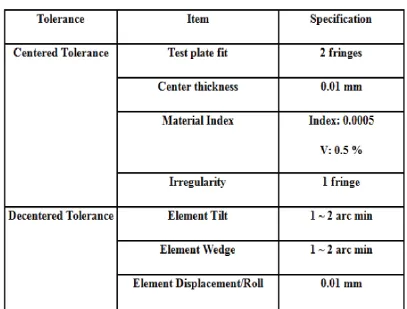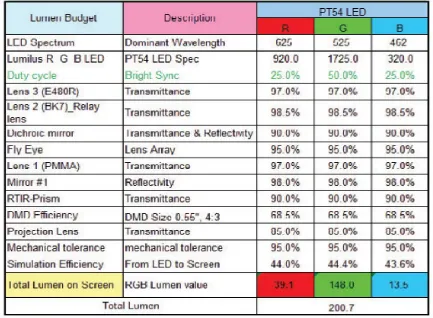5
III
March 2017
Technology (IJRASET)
Implementation of Led Projector
Miss. Prachi Dhurandhar1, Manjushri Badwaik2, Pranjali Chaware3, Shreya Ramteke4, Asst. Prof. Abhay Dakhole5
1,2,3,4
UG Student , 5 Assistant Prof , Electronics & Communication M.I.E.T. Bhandara, Bhandara, India.
Abstract: there are two parts of projector according to their desired characteristics. One of them brightness system it composes blue, green and red leds. Each of them has collimator diachronic filter collimated by dichronic filter it combine three wavelength lights together the last part is condenser the micro-lens array and tir prism is used to reduce the size of illumination system and illuminate dmd uniformly.
The one is imaging system. According to the standard of dmd; the effective focal length, angle of view , the imaging quality of lens and the relationship of imaging and object can be defined. By using optical simulation software, code v and zemax, the lens conform to the standards was well designed. Finally the meekness of production was analysed. In this design, the normal light efficiency of three wavelengths led on dmd is 51.13%, and the normal uniformity on dmd is 95.17%. Approximately the screen, the normal light efficiency is 44%, and the normal uniformity is 87.3%.
Keywords:— led, dlp, dmd, collimator, tir.
I. INTRODUCTION
The newest type of projector are handheld projector that use LEDs or LASERs to project images. There projection are difficult to see if there is too much surrounding light. LED projector are becoming more famous LED technology is being used in a wide range of products, including business and home theatre projectors, and education projectors, and even emerging markets of pico projectors, and other mini projector system these has its benefits in diversity of fields, with several different uses. Light emitting diode are the inventive generation of light source. LEDs are used to save the power and environmentally friendly. There are two types of properties of LEDs A long life and small size. In projector, the digital light processing and liquid crystal on silicon projectors has been widely used. In DLP projectors there are many advantages in replacing a conventional ultra-high pressure lamp with an LED light source. Most of all an LED light source has highly saturated colour with narrow bandwidth.
A projector is an optical device that projects an image onto a surface, commonly a projection screen. Most projectors create an image by shining a light through a small transparent lens, but latest types of projectors can project the image instantly by using lasers. A virtual retinal display, or retinal projector, is a projector that projects an image directly on the retina instead of using an external projection screen.
However the green, red and blue LED are light sources in a DLP projectors. According to our research homogenized LED illumination using micro-lens arrays for pocket size projector we can use an LED light source in our miniprojector where there are serious colour monotomy issues at the centre and corner of the projection screen.
how DLP projectors try to provide an image and the advantages and disadvantages DLP projector shall we cover in detail in the article.
What exactly is DLP technology: Digital light processing is a proprietry technology grow and belonging to the company texas instrument. To be used in a multimedia projectors. Originally produced by larry Hornbeck in 1987, digital light processing has become currently it is the most regularly implemented projector technologies, and is the main rival to LCD projector technology. How DLP technology generate an image: Central to how digital light processing projector display an image may be the digital micro-mirror device chip housed interior the projector. The DLP chip contain thousand of mirror, each can be used each pixel. To create a photo, the style source send information for the projector that reason the mirror to be adjusted on both vertical and horizontal axis, therefore varying the quantity of light which can be projected from the lens. The way in which projector generate colour is dependent on the number of digital micro-mirror device chips within projectors. The way in which single chip digital light processing projector along with three chip DLP.
How DLP technology works: During operation, the DMD controller loads each underlying memory sell with a “1” or “0”. Next, a micro-mirror clocking pulse is applied, reason each micro-mirror to switch to a plus or minus 12 degree landed state. In a projection system, the 12 degree landed state correspond to an “on ” pixel, and the -12 degree landed state corresponds to an off” pixels. Optical system : The optical system can be classified into two parts according to design characteristic. One is brightness system; and other is imaging system. projector system was consist of collimator lens, LED light source, diachronic filters, micro lens array, mirrors, condenser, TIR prism, DMD, and projection lens.
A. Lumination System
1) Led Specifications: led specification in these design we choose “phlatlight pt54 projection chip” to be our light source. Because of it is shiny enough hand the size is small. by pulsing RGB LED at heighting frequency more than 60 HZ and synchronizing with the corresponding colour the display on the DMD chip. A full colour image is projecting. It has collimated angular intensity distribution for Greenand Blue devices and Lambertian angular intensity distribution for Red devices. Over 1,300 white lumens at 8000KColor temperature from a single RGB chipset under continuous operation.
B. Implimentation of Collimator Lens
Because there is no condenser along Phlatlight RGB LEDs, and the contrast angle is wide. So we design collimator lens for LED to increase light efficiency and control the way of light. And the intensity is conformed . By using this condenser we can collect the lights in divergence angle.
Technology (IJRASET)
[image:4.612.107.514.396.705.2]Table 3: The light efficiency of each components in real case...
II. CONCLUSION
This design uses single R, G, B LED light source with collimator lens and Dichronic filters to replace the mercury lamp (UHP). It curtail reflector, UVIR filter and colour wheel. Using micro lens array supplant rod to increase uniformity and light efficiency. Andthe TIR prism was use to minimize the total track to 52mm. After consult the light efficiency, the projection size was implementation in 20 inch. The light efficiency in real case is 16.3% on the screen and the monotony on the screen is 87%.
REFERENCES
[1] L. J. Hornbeck, “Digital Light Process for High Brightness, High Resolution Applications”, Proc. Of SPIE, 3013, P27-40, 1997.
[2] Luminus Devices, Inc. Website http://www.luminus.com (part number 112658 (Red) part number 112659 Green) part number 112660 (Blue)) [3] Edward H. Stupp, Matthew S. Brennesholtz, Projection Display, John Wiley & Sons Ltd, England, 1999
[4] J.W.Bowron and R.P.Jonas,“Off-axis illumination design for DMD system,”Proc.SPIE 5186,72-82 (2003).
[5] L.J.Hornbeck,“Digital light processing for high-brightness,high-resolution applications,”in Projection Displays III,M.H.Wu, ed., Proc. SPIE 3013, 27-40 (1997).
[6] H. C. Burstyn, D.Meyerhofer, and P. M. Heyman,“The design of high-efficiency high-resolution projectors with the digital micromirrordevice,”in SID ’94 International Symposium Digest of Technical Papers (Society for Information Display,1994), pp. 677-910.
[7] G.H. Moss,R.G.Fielding,M.Kavanagh, and B.R. Critchley, “A high-luminance large-screen projection system using the digital micromirror device (DMD),”in SID ’96 International Symposium Digest of Technical Papers (Society for Information Display, 1996), pp al Research Associates, Ch. 5, 2005.
[8] Code V Introduction User’s Guide, Optic. 907-910.

